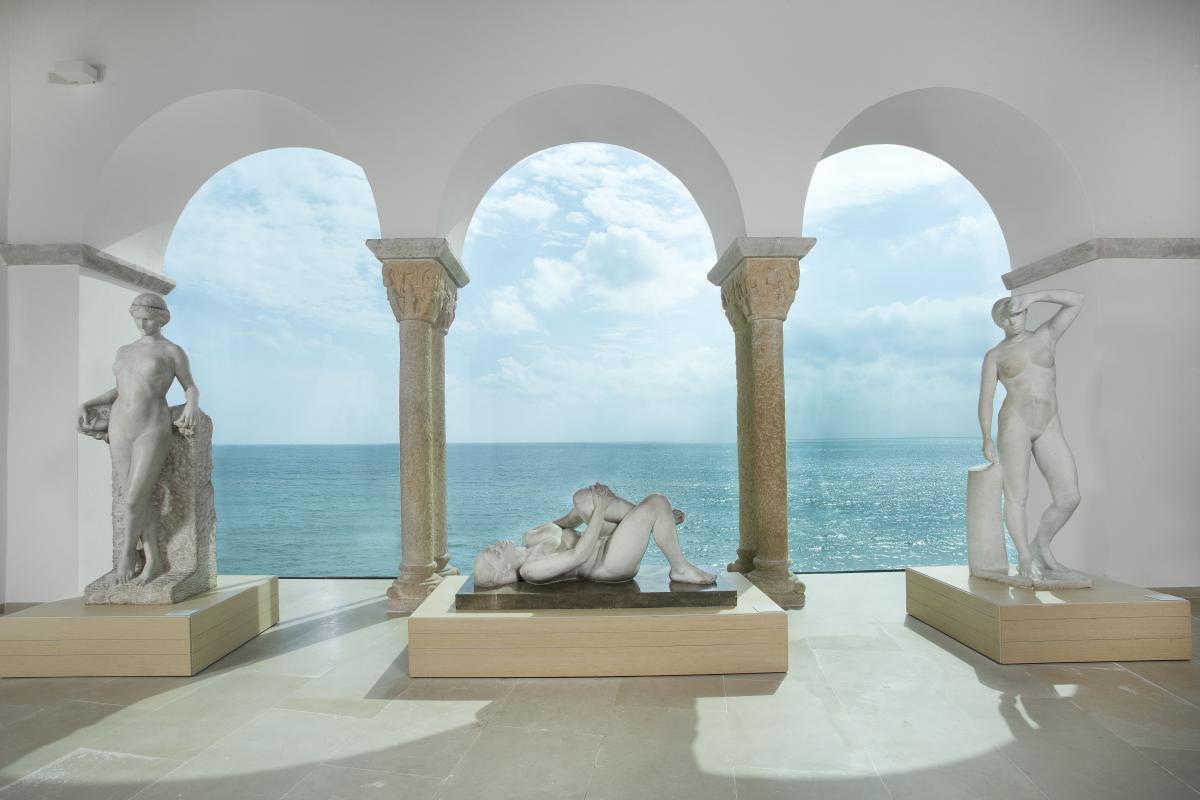
VIRTUAL TOUR OF THE MARICEL MUSEUM
The Maricel Museum exhibits a complete artistic route from the tenth century to realism and figuration during the first half of the twentieth century, passing through the art collections of Dr. Jesús Pérez Rosales and the Collection of Sitges, with works of great quality. The museum exhibition integrates multiple languages, techniques and artistic media in order to achieve a maximum consistency in the chronological sequence of the development of the arts.
The museum included works from the collection of Dr. Jesús Pérez-Rosales that never had been exhibited in public, acquisitions by the Sitges Heritage Association since 2012 (Ramon Casas, Miquel Utrillo, Arcadi Mas i Fondevila, Artur Carbonell i Augustí Ferrer Pino) and donations from artist’s relatives (Pere Jou and Alfred Sisquella).The museum's own collection was complemented with several works from loans and deposits from art collections of the Government of Catalonia, the Museum of the Provincial Government of Barcelona and the Montserrat Museum, primarily with artists from "Modernisme" and "Noucentisme" linked to Sitges as Ramon Casas, Joaquim Sunyer, Lola Anglada, Pere Jou and Alfred Sisquella, among others. It also emphasizes the incorporation of valuable pieces of furniture from the ancestral home of Can Falç, currently under restoration.
The visit to the Maricel Museum begins on the second floor of the building with sculptures and altarpieces belonging to the Romanesque and Gothic periods (works by Pere Serra, Master of All, Master of Maluenda, Master of Armisen, Master of Belmonte, Master of Son, Joan d'Angers, Master of Viella, the Virgin of Sant Miquel del Fai, Master of Los Balbases, Tomàs Giner and Pedro Berruguete, among others), supplemented with furniture. The Renaissance and Baroque are represented by collections of ceramics and furniture, as well as still lifes. On the first floor, in the former room of Deering, there's an exquisite selection of paintings (Arellano) and furniture dating from the eighteenth and nineteenth centuries.
Next are works from the Neoclassic period (Vicente Lopez) and Romanticism (Esquivel, Joaquim Espalter, Marià Fortuny, Federico de Madrazo); Realism (Felip Masó, Rafael Monleón Arcadi Mas i Fondevila and young Rusiñol), the hall dedicated to the Luminist School (Joan Roig Soler, Arcadi Mas i Fondevila, Antoni Almirall, Joaquim Miro i Argenter, Joan Batlle i Amell, Joan Soler i Casanovas and Càndid Duran); "Modernisme" (Santiago Rusiñol, Ramon Casas, Josep Llimona, Miquel Utrillo), with a hall dedicated to "Modernisme" in Sitges with the paintings that decorated "Cerveseria del Cau Ferrat" (Santiago Rusiñol, Arcadi Mas i Fondevila, Joaquim de Miro, Antoni Almirall, Càndid Duran) and "Noucentisme" (Joaquim Sunyer, Pere Jou, Lola Anglada, Enric Casanovas, Ismael Smith, Xavier Nogués, Josep M. Gol, Josep Clarà, Pau Gargallo, Jaume Otero, Josep Granyer and Apel·les Fenosa, among others).
The ground floor of the Maricel Museum covers four clearly differentiated areas. At the ancient Gothic chapel of the Hospital of Sant Joan and the contiguous room there's a sample that foreshadows the museum's collection, as one pair of capitals dating from the tenth century, the Maiestas Domini dating from the thirteen century and altarpieces of Sant Salvador d'Alzina de Ribelles (Jaume Cabrera, c. 1400) and the Virgin, dating from the fourteen century and works of Pedro Orrente, Antonio Almirall, Santiago Rusiñol, Ramon Casas and Pere Jou. Along with the chapel hall, the viewpoint is the most spectacular hall with views over the sea and three large "noucentista" sculptures (Joan Rebull). The Romanesque chapel hall dedicated to St. Bartholomew, .foueteen century, evokes Dr. Jesús Pérez-Rosales.
The long space that goes from the viewpoint to the Sert Hall is dedicated to realism and figuration in the interwar and postwar years with sculptures of Jou, Rebull, Casanovas and paintings of the Villà brothers, Mercader, Ferré Pino, Artur Carbonell, Sisquella and Pere Pruna. There's also a large sculpture of El Greco, the original work of Josep Reynés (1898) that was replaced by a copy in 1970 due to its derelict condition, the original is now in a museum.
The Sert Hall concludes the visit to the Maricel Museum, with large murals that are an allegory of the Great War painted between 1915 and 1916 in the hope of Allied victory.
Download the informative triptych


 Buy tickets
Buy tickets Buy tickets
Buy tickets


